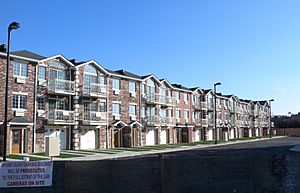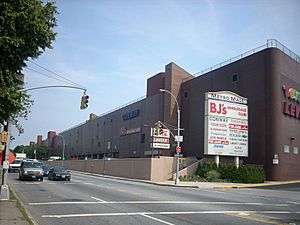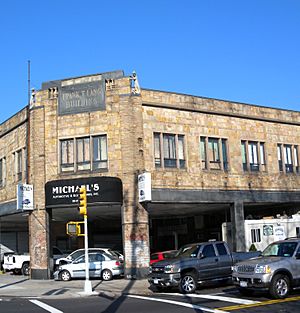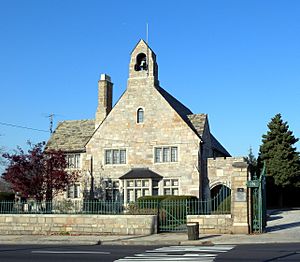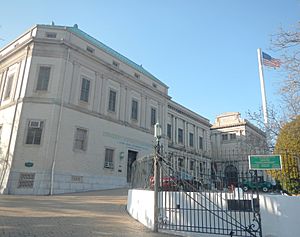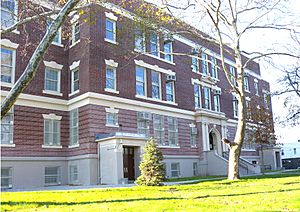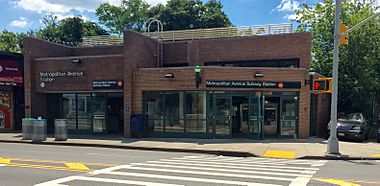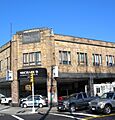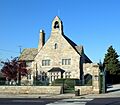Middle Village, Queens facts for kids
Quick facts for kids
Middle Village
|
|
|---|---|
|
Neighborhood of Queens
|
|
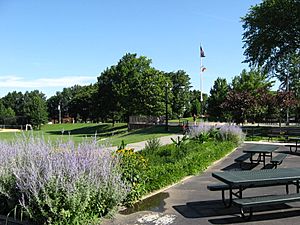
|
|
| Country | |
| State | |
| City | New York City |
| County/Borough | Queens |
| Community District | Queens 5 |
| Population
(2010)
|
|
| • Total | 37,929 |
| Ethnicity | |
| • White | 74.0% |
| • Black | 0.9% |
| • Hispanic | 15.8% |
| • Asian | 8.1% |
| • Other/Multiracial | 1.2% |
| Economics | |
| • Median income | $67,715 |
| Time zone | UTC−5 (EST) |
| • Summer (DST) | UTC−4 (EDT) |
| ZIP Code |
11379
|
| Area codes | 718, 347, 929, 917 |
Middle Village is a neighborhood in the central part of Queens, New York City. It is bordered by the Long Island Expressway to the north and Woodhaven Boulevard to the east. To the south, you'll find Cooper Avenue, and to the west, Mount Olivet Cemetery. A small area near Mount Olivet Cemetery is also often considered part of Middle Village.
This neighborhood is surrounded by other areas like Elmhurst to the north, Maspeth and Ridgewood to the west, Glendale to the south, and Rego Park to the east. Most homes in Middle Village are single-family houses, many of which are attached, along with some small apartment buildings.
Middle Village is part of Queens Community District 5. Its ZIP Code is 11379. The New York City Police Department's 104th Precinct patrols the area. For local government, Middle Village is represented by the 29th and 30th Districts of the New York City Council.
Contents
History of Middle Village
How Middle Village Got Its Name
People from England first settled this area around 1816. It got its name in the early 1800s because it was the midpoint between two towns: Williamsburg, Brooklyn and Jamaica, Queens. These towns were connected by the Williamsburgh and Jamaica Turnpike, which is now Metropolitan Avenue. This road opened in 1816.
Early Development and Changes
For a long time, Middle Village was not very crowded because a large area called Juniper Swamp was nearby. This swamp was once a hiding place for Americans during the American Revolutionary War. In 1852, a Lutheran church from Manhattan bought farmland on the western side of the area.
After the American Civil War, many German families moved to Middle Village. By 1873, the Williamsburgh and Jamaica Turnpike became a free road. In 1879, St. John Roman Catholic Cemetery was built on the eastern side of town. This led to hotels and other businesses opening to serve visitors to the cemetery. The western part of Middle Village was known as "Metropolitan" before World War I.
Growth and Housing Boom
The Juniper Swamp was filled in 1915. In 1920, the area was renamed "Juniper Valley" as part of a plan to make it more lively. A big housing boom started in the 1920s. This growth eventually covered the surrounding farmland. It connected Middle Village with nearby towns and neighborhoods.
Two main builders, Nansen Building Corporation and Baier & Bauer, constructed many of the early homes. Charles Baier's first project was Parkville Homes in 1927. These were 30 homes at Juniper Valley Road and 77th Place. With August Bauer, they built 150 single-family row houses by 1928.
People and Community in Middle Village
Population and Diversity
In 2010, Middle Village had a population of 37,929 people. This was a small increase from 2000. The neighborhood covers about 1,329 acres.
The community is quite diverse. In 2010, about 74% of residents were White, 0.9% African American, and 8.1% Asian. About 15.8% of the population identified as Hispanic or Latino.
Health and Income
The average life expectancy in Middle Village and nearby areas is about 81.4 years. This is similar to the average for all of New York City. Most residents are young and middle-aged adults. About 22% are under 18, and 31% are between 25 and 44.
In 2017, the average household income in this area was $71,234. About 19% of residents live in poverty, which is similar to the rest of Queens and New York City. Also, about 6% of residents are unemployed.
Community Changes Over Time
Historically, many people in Middle Village were of German descent. Later, many Irish, Italian, and Yugoslavian Americans moved here. More recently, there has been an increase in Polish, Eastern European, Hispanic, and Chinese American residents. Many older families have kept their homes and passed them down to their children. This means many residents are second or third generation.
Places to Visit in Middle Village
Shopping and Entertainment
- Metro Mall: This shopping mall is located on Metropolitan Avenue. It has three levels. In the 1920s, a factory that made telephone booths was on this site. The factory closed around 1965. Then, a mall was built between 1972 and 1974. Today, some stores like BJ's Wholesale Club and Raymour & Flanigan are still there. The New York City Department of Corrections also has a training academy in the mall. In 2024, the mall was renamed the Shops at Rentar Plaza.
- The Arion Theater: This theater was built in 1921 on Metropolitan Avenue. It had one screen and 970 seats. It was the first theater in Queens with wiring for loudspeakers. It closed in the mid-1980s. As of 2016, a Salvation Army location is on the site.
Historic Buildings
- The Frank T. Lang Building: This building was constructed in 1904 at Metropolitan Avenue and 69th Street. It is named after Frank Lang, who built mausoleums and monuments. The building sold these items until 1946. It also had a gas station. This two-story art deco building is special because of its gargoyles and carved faces on the roof.
- Niederstein's: This was a famous local restaurant at 69-16 Metropolitan Avenue. It was torn down in 2005. In 1850, Henry Schumacher built a two-story wooden hotel and saloon called Schumacher's Lager Beer Saloon and Hotel on this site. In 1888, John Niederstein, a German cook, bought the business. He added 32 rooms and ran it as a hotel. The restaurant was very popular for many years. However, it became less popular by the 1990s. The building was sold and demolished in 2005 to make way for a new restaurant.
- The Artistic Building: This building, built in 1930, is on Metropolitan Avenue between 79th and 80th Streets. It is known for its friezes, which are decorative bands with carvings of biblical scenes on its front. As of 2005, it was a tailor's shop.
- Old Houses: Middle Village also has some very old houses. The Morrell House, built in 1719, was on Juniper Valley Road but was torn down in 1985. In 2005, a local group called the Juniper Park Civic Association helped protect parts of Middle Village from too much new building. An old farmhouse from the 1890s on Furmanville Avenue still stands today.
Cemeteries and Crematory
- Lutheran All Faiths Cemetery: This cemetery opened in Middle Village in 1852. It was created because new cemeteries were not allowed in Manhattan. The General Slocum Steamboat Fire Mass Memorial is here. This memorial remembers the 1,021 people who died in the 1904 sinking of the PS General Slocum. The parents of former U.S. President Donald Trump, Fred Trump and Mary Anne MacLeod Trump, are also buried here.
- Fresh Pond Crematory and Columbarium: Near the Lutheran All Faiths Cemetery is the Fresh Pond Crematory and Columbarium. It has been operating since the late 1800s. Many famous people were cremated here, including baseball player Lou Gehrig and businessman J.P. Morgan. The crematory was built in 1884. The columbarium, where ashes are stored, was built in 1893 and made larger in 1898.
- Pullis Farm Cemetery: This is a small, gated burial plot inside Juniper Valley Park. It dates back to 1846. About eight members of the Pullis family are buried there. The cemetery was overgrown with weeds but was cleaned up and given a new headstone between 1993 and 1996. It is one of the few old farm burial grounds left in New York City.
- St. John's Cemetery: This cemetery in Middle Village is the burial place for many notable people. These include fitness expert Charles Atlas, politicians Geraldine Ferraro and Mario Cuomo, and police officer Rafael Ramos.
Religious Institutions
Middle Village has several important religious buildings.
- United Community Methodist Church: This was the first Methodist church in Middle Village. It was founded in 1769. The church was moved in 1836 and rebuilt in 1901 and 1926.
- Trinity Lutheran Church: This church was founded in 1851. A school was opened there in 1861. The church burned down in 1863 and moved to 69th Street. Both the school and church burned down again at that location. The current church building, built in 1979, is located on Penelope Avenue. Bells and cornerstones from the first two churches are still displayed there.
- St. Margaret's Roman Catholic Church: This church and its school were built in 1860. During the American Civil War, it was used as a temporary jail. Both the school and church were rebuilt later. In 1935, they moved to a four-story building on Juniper Valley Road.
- Our Lady of Hope: This church, built in 1965, has a unique hexagonal shape and a bell tower. It is located on Eliot Avenue.
- Synagogues: In the early 1900s, many Jewish residents moved to Middle Village, leading to several synagogues. The Hebrew Institute of Middle Village, a rabbinical school, was built in 1919. The building is now the Middle Village Adult Center. The Holy Archangels Michael & Gabriel Romanian Orthodox Church moved into a former synagogue in 1997. The only active synagogue in the area today is the Congregation of Forest Hills West, founded in 1935.
Fire Safety
The New York City Fire Department (FDNY) has a fire station, Engine Co. 319, at 78-11 67th Road.
A volunteer fire department called Fearless Hook and Ladder Company No. 7 operated in Middle Village from 1891 until 1913.
Parks and Recreation
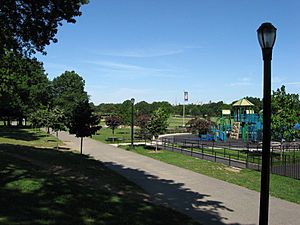
- Juniper Valley Park: This large public park is in northern Middle Village. It was built in 1930 on what used to be the Juniper Swamp. The park has courts for tennis, handball, basketball, and bocce. It also has seven baseball fields and a running track around a turf football/soccer field.
- Middle Village Playground: This park is located at 79th Street between 68th Road and 69th Avenue. The city bought the land in 1938 and updated the playground in 1994.
- Middle Village Veteran's Triangle: This memorial is at Gray and 77th Streets. It honors local people who served in World War I, World War II, the Korean War, and the Vietnam War. It was renovated in 1999.
Post Office and ZIP Code
Middle Village uses the ZIP Code 11379. The United States Post Office has its Middle Village Station at 71-35 Metropolitan Avenue.
Education
School Performance
Compared to the rest of New York City, Middle Village, Ridgewood, and Maspeth have a slightly lower number of college-educated residents. However, students in these areas are doing well in school. The percentage of elementary school students who are good at math increased from 36% in 2000 to 67% in 2011. Reading skills also improved during the same time.
Fewer elementary school students in Middle Village miss a lot of school days. Only 14% missed 20 or more days in a school year, which is better than the city average. Also, 82% of high school students in Middle Village graduate on time, which is higher than the city average of 75%.
Schools in the Area
- Public Schools: Elementary and junior high schools that teach grades K–8 include PS/IS 49, PS/IS 128 (which was recognized as a Blue Ribbon School), and PS 87.
- Catholic Schools: Our Lady of Hope, St. Margaret, and Resurrection-Ascension are three Catholic K-8 schools in Middle Village. Christ The King Regional High School is another religious school in the area.
Library Services
The Queens Public Library has a branch in Middle Village. It is located at 72-31 Metropolitan Avenue.
Transportation
The neighborhood has a New York City Subway station called Metropolitan Avenue (M train).
Middle Village is also served by several local bus lines:
- The Q29 runs along Dry Harbor Road and 80th Street.
- The Q38 runs on Eliot and Penelope Avenues.
- The Q47 runs on 80th Street.
- The Q54 runs on Metropolitan Avenue.
- The Q67 runs on 69th Street and Metropolitan Avenue.
Additionally, express bus routes to Manhattan, including the QM24, QM25, QM34, serve the neighborhood along Eliot Avenue.
Notable People from Middle Village
Many interesting people have lived in Middle Village:
- Nicole Bass (1964-2017), a professional female bodybuilder and wrestler.
- William N. Conrad (1889-1968), a politician who served in the New York State Senate.
- Hyman Golden (1923-2008), who helped start the Snapple Beverage Corporation.
- Verna Hart (1961–2019), an African-American artist known for her expressionist paintings about jazz music.
- Jack McGlynn (born 2003), a professional soccer player for Philadelphia Union.
- Vincent Piazza (born 1976), an actor known for his roles in Boardwalk Empire and Jersey Boys.
- Mike Repole (born 1969), the CEO and creator of Vitamin Water.
Images for kids
-
The playground in eastern Juniper Valley Park


